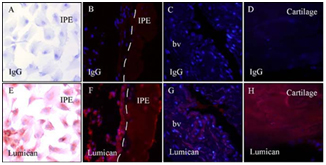Spondyloarthropathies (SpAs) are a family of inflammatory processes associated with HLA B27 polymorphism that develop into a number of conditions such as fusion of the spine or ankylosing spondylitis (AS), Reiter’s syndrome (or reactive arthritis), psoriatic arthritis, Crohn’s disease (a type of IBD) and uveitis.
Our researchers believe that they have discovered the mechanism of action for SpAs , based on shared homology of specific peptide sequences that occur in Chlamydia trachomatis and also in a protein called lumican which is preferentially and abundantly expressed in the locations where SpAs manifest. The shared peptide sequences have very high binding affinity to HLA B27, allowing the triggering of the immune response.

Lumican staining in human iris pigment epithelial cells (IPE),
iris and synovial tissues. Human IPE cultures (A and E), iris
tissues (B and F), synovial tissues (C-D, G-H) were labelled
with anti-lumican or control rabbit IgG, followed by HRP or
Alexa-fluor conjugated goat anti-rabbit IgG. Lumican staining
(red) is present in IPE in vitro (E) and in vivo (F), in blood
vessels (bv) (G) and in articular cartilage (H). Original
magnification x100 (A, E) and x400 (B-D, F-H).

由于技术保密工作限制,技术信息无法完全展现,请通过邮箱或短信联系我们,获取更多技术资料。
specific peptide sequences
high binding affinity
control rabbit igg
original magnification x100
shared peptide sequences
